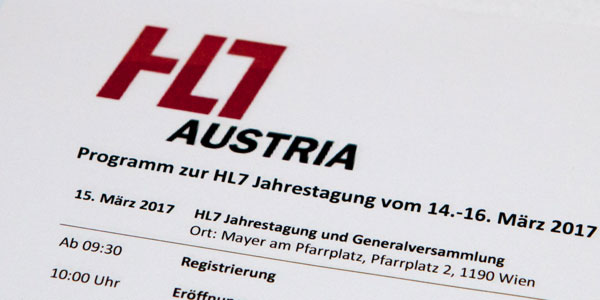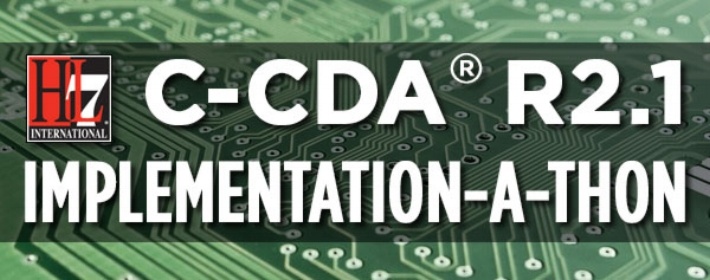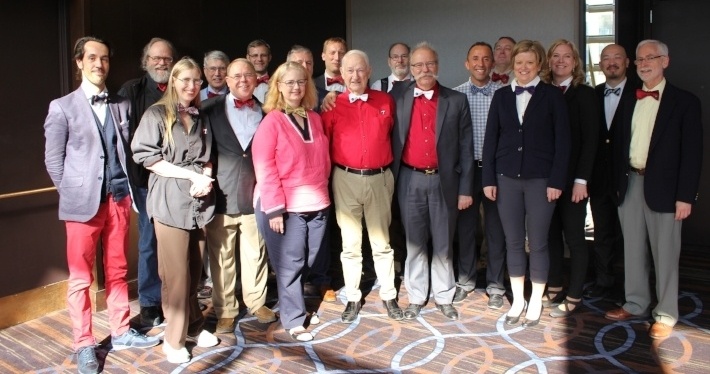A Little About HL7
The HL7 Fundamentals Course is Fundamentally Different
[fa icon="calendar'] Aug 3, 2018 11:07:26 AM / by Sadhana Alangar, PhD posted in FHIR, HL7 education, HL7 Affiliates, CDA, HL7, Version 2, interoperability, Version 3
HL7 Austria Celebrates 10th Anniversary
[fa icon="calendar'] Apr 12, 2017 2:14:24 PM / by Dr. Stefan Sabutsch posted in FHIR, CDA, HL7, HL7 community
Small but Mighty
HL7 Austria's annual assembly has become an insider’s guide to the eHealth community. This small but mighty event was held on March 15, 2017 at its regular location, the Heuriger, a local winemaker’s tavern, with a record attendance of more than 100 participants. The annual assembly included a a full day of presentations with timley information, education and networking. We also celebrated the 10th anniversary of HL7 Austria.
More than 20 speakers from four countries delivered engaging talks on the importance of standardization and HL7 in the eHealth area. The presentations covered a wide range of topics that demonstrated what goals have already been accomplished and what work still needs to be done to support interoperable electronic health data exchange in the future.
Release of the HL7 C-CDA® R2.1 Companion Guide
[fa icon="calendar'] Mar 9, 2017 2:17:57 PM / by Health Level Seven posted in CDA, HL7, HL7 community, health IT, C-CDA
Introducing the HL7 Companion Guide to Consolidated Clinical Document Architecture (C-CDA®) 2.1
On March 3, 2017, Health Level Seven International and the Duteau Design Inc. team of Jean Duteau, Joginder Madra, Helen Stevens, and Lisa Nelson published the Companion Guide to Consolidated Clinical Document Architecture (C-CDA) 2.1. This companion guide is a supplement to HL7's CDA R2 Implementation Guide (IG): C-CDA Templates for Clinical Notes STU Release 2.1.
Working Together: Our Best Option to Improve C-CDA® Content
[fa icon="calendar'] Nov 29, 2016 1:41:10 PM / by George Cole posted in CDA, HL7, HL7 community, interoperability, health IT, C-CDA
Working Together: Our best option to improve C-CDA® Content
Most people have heard of HL7 Fast Healthcare Interoperability Resources (FHIR®) Connectathon events, as well as IHE North America and European Connectathon events, which focus on testing the interoperability of solutions. But did you know that one of the most important content efforts – improving C-CDA® (Consolidated Clinical Document Architecture) documents – is also underway? At each HL7 C-CDA® Implementation-A-Thon, health IT activists have met to improve C-CDA quality and resolve industry differences that result from varying interpretations of standards and implementation guides.
Efforts to Improve the Content of the C-CDA
Many efforts are underway across the industry to help all of us improve the content of C-CDA documents. For example, the Relevant and Pertinent project and the ONC Site C-CDA Scorecard. For anyone who wants to improve C-CDA content quality, you will make the best use of your time at an HL7 C-CDA Implementation-a-Thon.
These two-day events provide an opportunity for multiple participants (20 – 30) from a diverse cross-section of companies and government agencies (16 – 20) to tackle specific use cases for both content creation and content consumption.
What We’ve Accomplished So Far at the C-CDA Implementation-A-Thons
Through the past three C-CDA Implementation-A-Thons, we have accomplished the following:
- Identified many inconsistencies in how document content has been created and consumed
- Clarified language in implementation guides
- Suggested and actually written material for the upcoming C-CDA R2.1 Companion Guide (see C-CDA R1 Companion Guide here)
- Made best-practice statements on a variety of topics
- Exchanged ideas with ONC about certification, validation and document scoring
At Allscripts, we have products that cross the continuum of care, with the ability to both produce and consume CDA-based documents. I am fortunate to work with the very talented Community Solutions group, which is responsible for the creation and consumption of all CDA-based documents for Allscripts products.
Yet, even with this single, focused approach at Allscripts, we are still faced with a number of interesting choices about data, and the construction and consumption of CDA documents. Participation in the C-CDA Implementation-a-Thon events resulted in us making some useful changes, and feeling confident that these were changes made with an industrial consensus for producing an improved quality of C-CDA.
Is HL7's FHIR Ready To Revolutionize Interoperability in LATAM? Is LATAM Ready for FHIR? Part 1
[fa icon="calendar'] Sep 28, 2016 9:54:40 AM / by Diego Kaminker posted in FHIR, CDA, HL7, HL7 community, Version 2, Latin America, interoperability
A little history
Studying HL7 history, our standards went from a plain text, replication/messaging-based paradigm in the 1980s to the current, Internet 2.0, resource-based paradigm. We also created document-based standards such as the Clinical Document Architecture (CDA®) Release 2 and SOA based standards like Common Terminology Services (CTS).
These 30 years of history gave us a good insight on what we need as standards users and developers.
What do we need as standards users?
People who implement and use standards want open access to standards and implementation guides. They need understandable and short specifications, off-the-shelf tools, reference implementations, friendly representation of information (instances), easy access to vocabularies, automated validation of instances, affordable education, a formal extension mechanism.
Finally, they need examples, examples, and more examples. They need lots of examples!
What do we need as standards developers?
Standards developers have different needs. They want easy profiling with graphical user interfaces (GUI) and the ability to reuse templates. They also want one-click, automated publishing, validation and QA profiles, validation of instances, global profile registry, and ease of vocabulary binding.
The Power of Community in HL7
[fa icon="calendar'] Sep 15, 2016 9:04:51 AM / by Russ Leftwich, MD posted in FHIR, CDA, HL7, HL7 community, interoperability
The Power of Community in HL7
I first became involved with HL7 a decade ago as I transitioned from medical practice to clinical informatics. I attended my first HL7 meeting, as many do, to take advantage of the tutorial sessions offered around foundational standards like HL7 Version 2 and the Clinical Document Architecture (CDA®). The most valuable takeaway from that first meeting however was not the knowledge of the standards but the beginning of my relationship with the community of individuals who are HL7.
HL7 is a diverse community
It is a remarkable community of individuals that are as diverse as the countries they call home, the organizations that employ them, and their backgrounds of education and experience. The one thing that is common and shared across the community is the sense that we move the needle as a community; move the needle a little with each use case enabled with an HL7 standard and each project that ends with consensus on a new data standard.
Q&A with Bryn Lewis, PhD: HL7 C-CDA® Rendering Tool Challenge Winner
[fa icon="calendar'] Sep 13, 2016 3:21:45 PM / by HL7 posted in CDA
Q&A With Bryn Lewis, PhD
First Place Winner of the HL7 C-CDA® Rendering Tool Challenge
On Tuesday, September 12, HL7 announced the winners of the HL7 Consolidated Clinical Document Architecture (C-CDA®) Rendering Tool Challenge.
Bryn Lewis, PhD, a principal software development consultant at Intelsoft in Melbourne, Australia, developed the award-winning tool, Intelsoft C-CDA Viewer. Dr. Lewis's tool is an easy-to-use viewer of complex C-CDA documents available in any web browser.
C-CDA® Rendering Tool Challenge Background
Many clinicians are frustrated with the usability of C-CDA documents. Currently, an overabundance of data is rendered and sent to providers, requiring them to spend time sorting through data that is not relevant to their immediate needs.
HL7 and the Office of the National Coordinator for Health Information Technology (ONC) addressed this need by issuing a tool challenge to develop a viewer to enable clinicians to select the C-CDA document data most clinically relevant to them and display such data in an order they prefer.
The tool was required to meet the following criteria:
- Render the data as specified by the clinician thereby allowing him/her to quickly review the current health and needs of the patient
- Present requested data quickly and clearly through section-based view preferences (ordering), filter functions, intelligent sorting or some other functionality
Dr. Lewis was kind enough to share answers to the following questions ...
HL7 Foundation in Europe: Five Years of Growth for the European Office
[fa icon="calendar'] Sep 1, 2016 10:00:00 AM / by Catherine Chronaki posted in FHIR, HL7 Affiliates, ART-DECOR, CDA, HL7 Europe, interoperability
HL7 as an International Organization
The whole idea of regional offices for HL7 goes back to Ed Hammond’s third HL7 chairmanship in 2008-2009, inspired by the vision to turn HL7 into a truly international organization. This began with changing the organization’s name from Health Level Seven, Inc to Health Level Seven International.
It was not the first time that HL7 Europe came up in discussions. In the 1990’s, the European HL7 affiliates abandoned the idea thinking there wasn’t enough common ground: HL7 was the place for global standards development and localization was national business: France, Italy, and Germany had as much in common as with Australia, Canada, and Japan.









